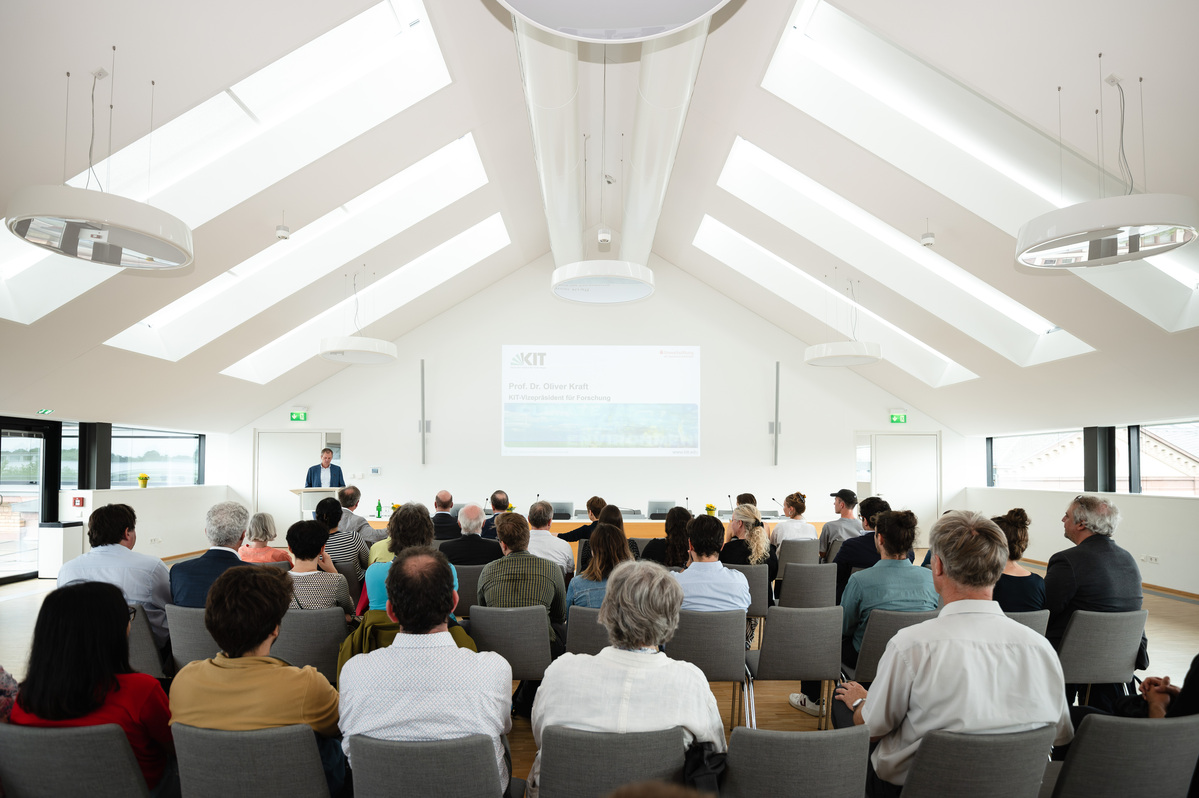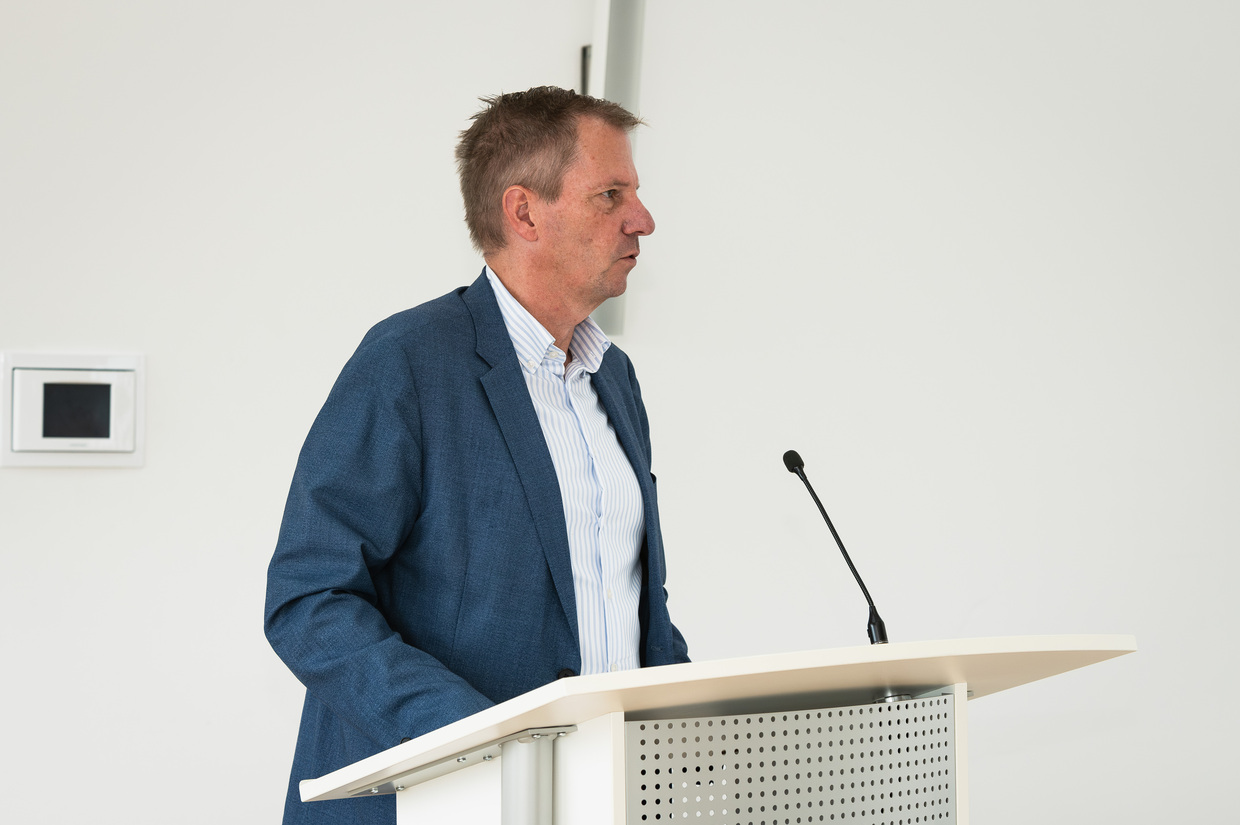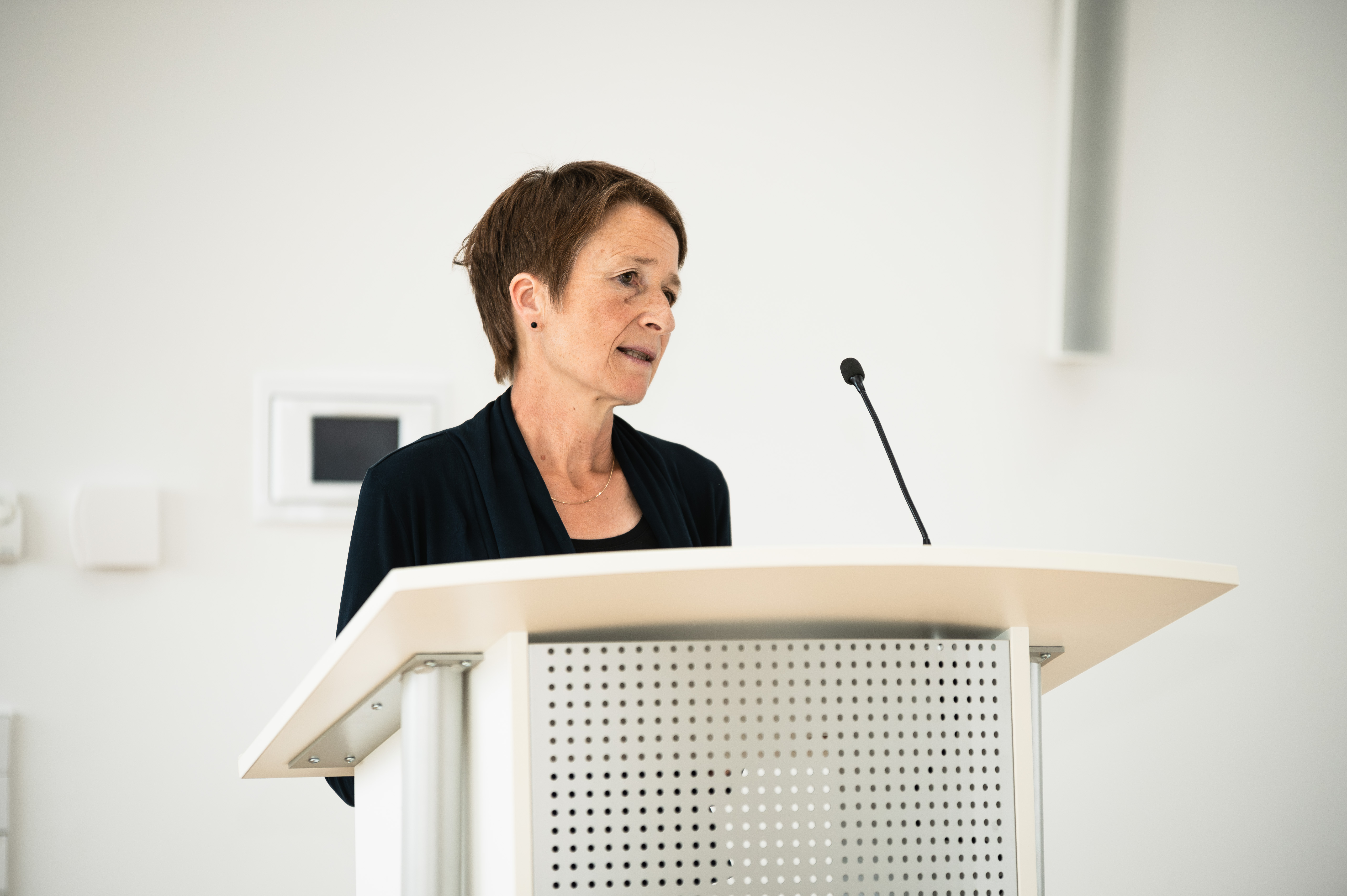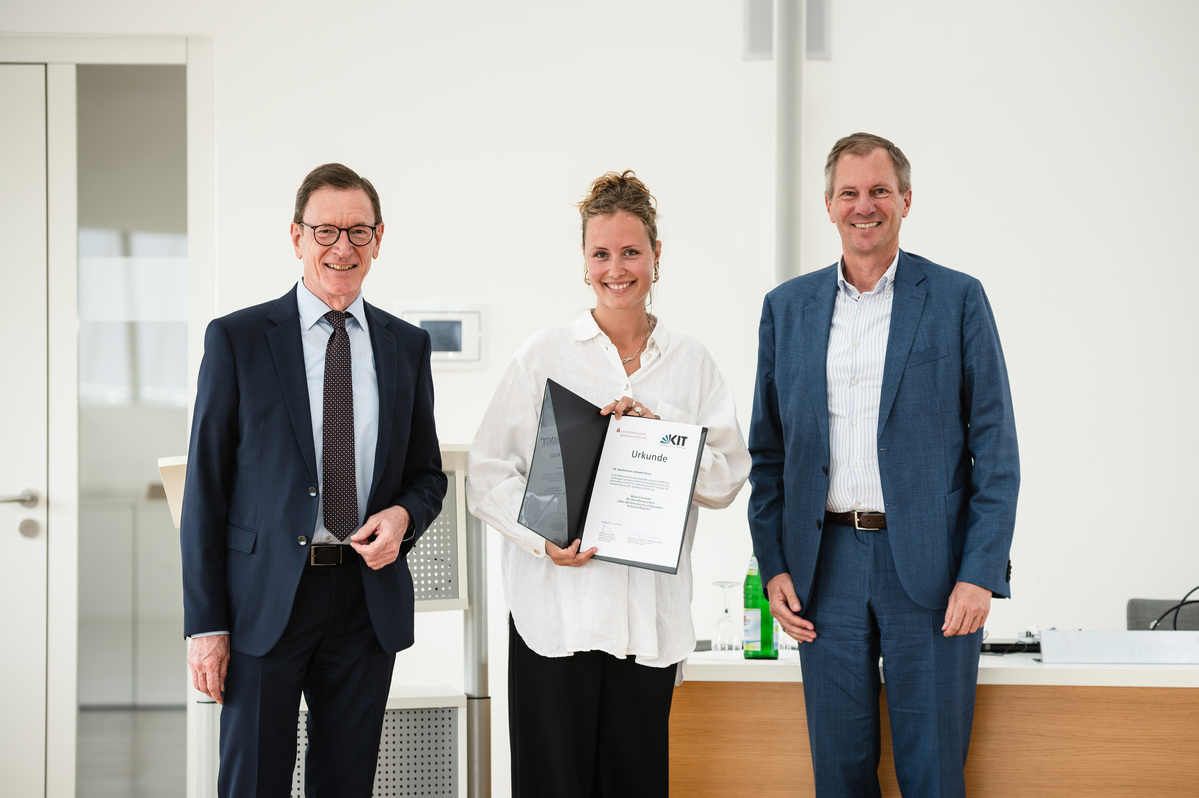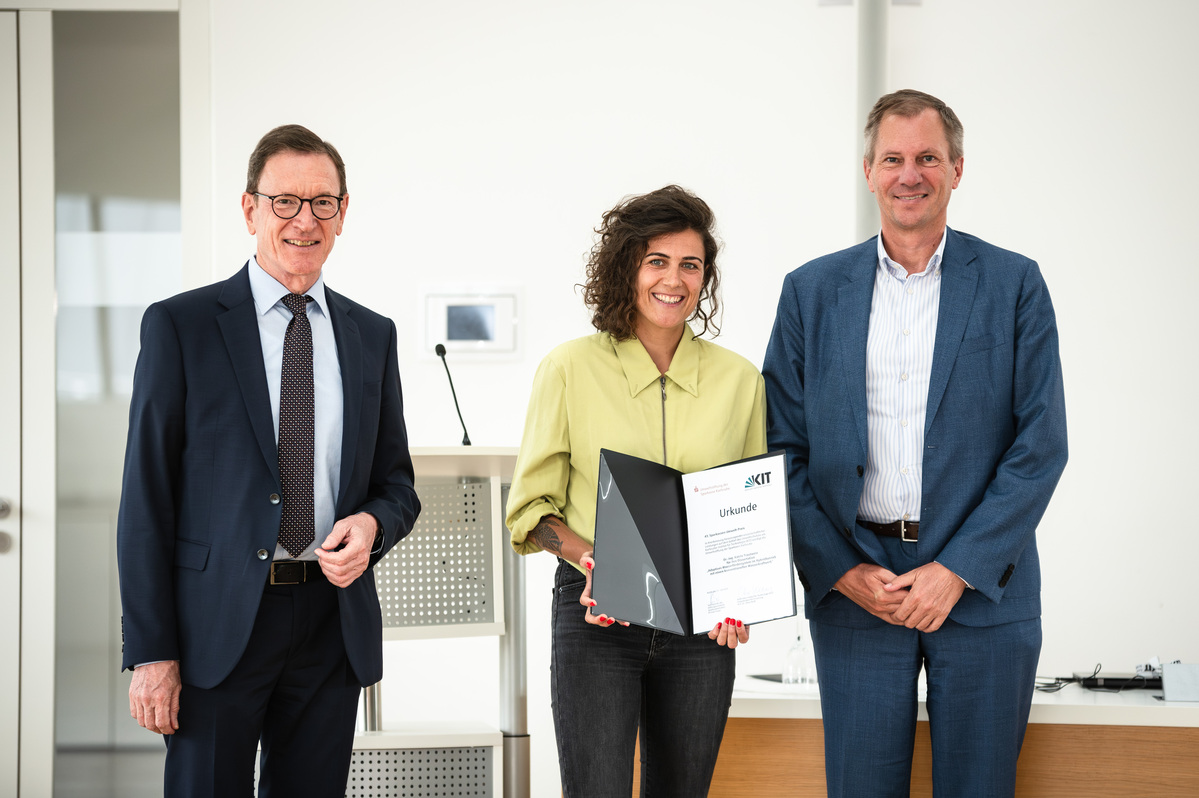Sparkasse Environmental Award 2022
The Sparkasse Environmental Award was presented on July 27, 2023 in the KIT Senate Hall in the usual large gathering as part of the annual meeting of the KIT Center for Climate and Environment.
After a short welcome speech from the executive committee by Prof. Oliver Kraft and the city of Karlsruhe by Bettina Lisbach and the Sparkasse Environmental Foundation by Michael Huber, the short lectures by the award winners and the awarding of the Sparkasse Environmental Award 2022 followed (moderation by Prof. Eiff).
The 2022 award winners are:
Masterthesis: M.Sc. Alisa Schneider (Institute for Buildingn design and technology, KIT): About the conversion of decommissioned coal-fired power plants
With the coal phase-out, over 13,000 power plant blocks worldwide will become obsolete. The finite nature of resources leads us to think of the world in a circular manner. Architectures are huge raw material mines, power plants of high architectural value. In order to secure remaining natural resources, the continued use of existing infrastructure to protect open spaces is essential. The industry of the future will no longer be harmful to the climate, but rather resilient and sustainable. The aim is to holistically network electricity, heat, production, food and housing in the form of a climate-positive power plant settlement.
The construction sector is responsible for 40% of global greenhouse gas emissions and almost 90% of waste. It is also an intensive consumer of mineral resources. Living spaces must be rethought - also due to the climate crisis and geopolitical conflicts. Energy/transport/construction/agricultural transitions shape our times and must be accelerated.
The coal-spinning climate settlement will become a new living space, combining the function of a power plant, industrial production and resilient agriculture. Through this networking, the different areas complement each other and benefit optimally from each other, in the spirit of a functioning circular economy. The renaturation of huge natural areas is a central aspect; the destroyed spaces should be carefully returned to nature and actively supported in their healing. The result is a place for people and nature, for industry and agriculture, a supra-regional meeting point, a settlement in which topics such as the climate crisis and its various actors can exchange ideas and educate themselves. All utility infrastructure - including energy generation, food cultivation, housing, common areas, and natural zones - is located on site in the settlement.
The power plant 4.0 provides electricity, heat, food, living space, community, nature, productivity and creativity; It thus embodies the intersectional networking appropriate to our times and is intended to serve as a pilot project for dealing with decommissioned large industrial facilities and power plants. The growing shortage of living space must also be prevented, but newly created living space must be designed and thought of in a sustainable and circular manner.
New residential units can be found in the former boiler house; the old steel frames serve as a frame for flexible wooden construction units inside with a total building height of around 45 meters. The existing stairwells for boiler maintenance are still there and are used as access and escape stairs. The surrounding concrete levels around the boiler frames become neighborly balcony-like areas for the residential units with views over the surrounding landscape. The encounter between the old, technical industrial architecture and the new type of wooden construction becomes an exciting game; Heavy, mineral components such as steel beams, metal stairs and reinforced concrete meet warm, organic wood and soft textiles and merge into a modern yet honest architecture. The residential units can be designed very flexibly; they follow a clear grid. The rooms are arranged in such a way that the residential units can be made larger or smaller if necessary. All units can be formulated barrier-free. The aim is to achieve a high level of flexibility of use for different age groups and needs. The goal is to create spaces that promote coexistence among residents through adaptability. The ground floor zone is zoned and designed by communal areas, workshops, small craft businesses and restaurants. From here there is a direct connection to the complex's unique cooling towers, which are also used by the public. Sports facilities take place on the roofs of the residential towers, from which you can look over the villages, the renatured opencast mines and other power plant settlements - including Neuenrath. The concept of the coal slingshot settlement is intended to be further developed and changed by the residents over time as a cooperative-like construct.
PhD-Thesis: Dr. Kathin Trautwein (Institut of Water and River Basin Management, KIT):
“Adaptive water pumping system in hybrid operation with a conventional hydroelectric power plant – example in a mountainous region in the north of Vietnam”
The basic supply of energy and water is the basis of human existence and is almost always inextricably linked. While highly developed technologies and the economic resources necessary for sustainable water management are available in industrialized countries, the conditions in developing and emerging countries are often catastrophic and existentially threatening. In addition to the partly. Due to extreme climatic and natural challenges, there are serious energy and technological hurdles in many regions with regard to the use of water technologies, as well as structurally-related administrative deficits to ensure the sustainable operation of water management systems. Many concepts fail in water shortage areas in the medium and long term due to the financial requirements for maintenance and operation of pumping systems, for example, as well as the lack of constant knowledge transfer for the sustainable use of water pumping and distribution concepts.
The concept developed as part of this work can be used, among other things, to expand the existing infrastructure of conventional hydroelectric power plants with a flexible, needs-based water pumping concept. In tropical and subtropical climate zones, many hydroelectric power plants are almost idle during the dry season due to low discharge volumes. However, the residual water quantities can generate the driving energy for water pumping using a bypass. Inversely operated pumps as turbines (PAT) are used as mechanical drive units for feed pumps. Particularly for emerging countries, PATs represent a good alternative to expensive and technically complex turbine technology due to their robustness and easy maintenance. Innovative solutions were developed as part of the KaWaTech project to design such a PAT-supported delivery module for high-pressure conditions as well as the hydraulic and operational connection to existing hydroelectric power plants being found. A pilot plant was implemented in the Vietnamese province of Ha Giang, which has since ensured the water supply for several thousand people. The practice-oriented empirical values serve as a starting point worldwide for the implementation of similar projects in regions of need with comparable boundary conditions.
PhD-Thesis: Dr. Andreas Wunsch (Institut of Applied Geosciences, KIT): Leveraging Artificial Neural Networks for Modeling Hydrogeological Time Series
To solve global challenges in the area of water resources, the development of new, efficient and easily transferable modeling approaches is crucial. Artificial neural networks (ANNs) are particularly suitable for this. As machine learning processes, they can independently learn and use relevant relationships from larger data sets. Based on four studies, the present work demonstrates the application of ANNs for modeling and forecasting hydrogeological time series.
Cluster analyzes can be used to identify spatial and temporal patterns of groundwater dynamics. This is important for characterizing aquifers, identifying influencing factors and developing management plans. For these reasons, the first study develops a clustering method that can be used to group groundwater hydrographs with similar dynamics in heterogeneous data sets. The method can also process time series with variable data quality and its application is successfully demonstrated using data from the Upper Rhine Graben in Germany and France.
An analysis of the results shows that influencing factors overlap spatially and temporally in a complex manner and that separation is often not possible, although some clusters can still be clearly traced back to specific factors (e.g. surface water).
The second study compares various ANN models for groundwater level prediction. Nonlinear Autoregressive Models with Exogenous Inputs (NARX), Long Short-Term Memory Networks (LSTM) and Convolutional Neural Networks (CNN) are examined. Widely available meteorological variables serve as input data, which ensures broad transferability of the methodology. Using groundwater data from the Upper Rhine Graben, it can be seen that all model types generally have good forecasting properties, but CNNs have the greatest potential for practical applicability. They achieve a high level of prediction quality, show good prediction stability, can be implemented flexibly and also have a calculation speed that is many times faster than both recurrent alternatives.
The following study examines the development of groundwater levels in Germany in the context of climate change. For this purpose, future groundwater levels at 118 selected measuring points in Germany are modeled based on CNNs and temperature and precipitation from three climate scenarios (RCP2.6, 4.5 and 8.5) and the direct influence of the future climate is estimated. However, important secondary factors such as anthropogenic influences are not included in the simulations. Under RCP8.5 (pessimistic scenario), widespread and pronounced falling groundwater levels are to be expected, with a spatial pattern of greater declines, especially in northern and eastern Germany. The results for the more optimistic scenarios RCP2.6 and RCP4.5 also show decreasing trends, but with comparatively few significant changes. The positive influence of reduced greenhouse gas emissions becomes clear here, but even for the most optimistic scenario RCP2.6, some projections show declining groundwater levels across Germany.
Finally, karst spring fills are the focus of the work. On the one hand, the existing (1D) CNN approaches are used for modeling, and on the other hand, a 2D approach, which is also based on CNNs, is being developed, which allows the direct processing of areal raster data as inputs. This solves the common problem of missing weather station data as input data in the catchment area. Both approaches show very good results in all three test areas in Austria, Slovenia and France and in some cases even exceed the results of existing models. The 1D and 2D approaches usually achieve similar prediction quality and neither is systematically superior. However, in detail it becomes clear that the spatial and temporal completeness of the input data represents a clear advantage of the areal approach. Furthermore, a sensitivity analysis shows the potential of the 2D approach for the localization of source catchments and demonstrates that ANNs can learn physically plausible relationships.
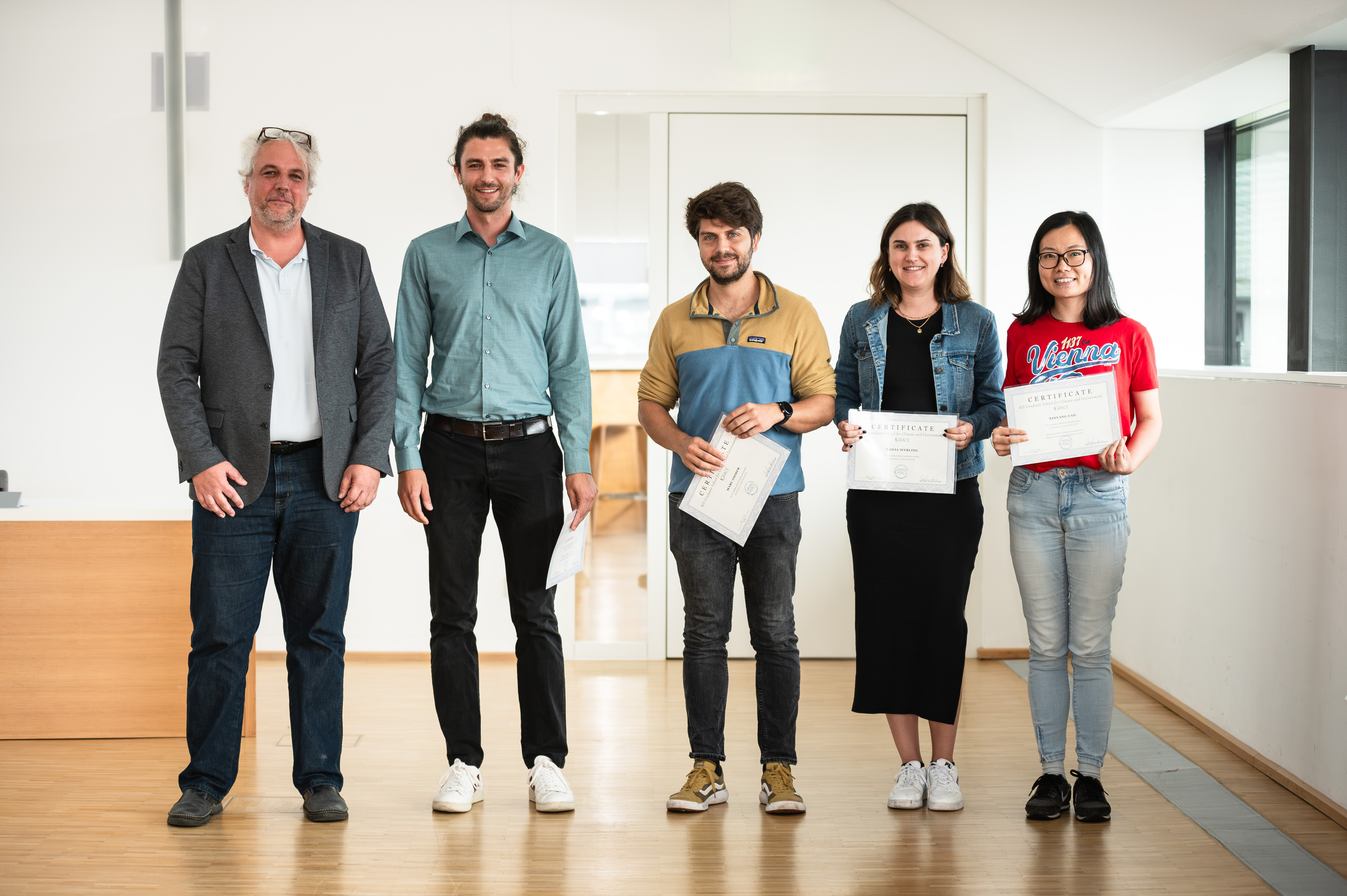
After presenting the GRACE certificates to the graduates of the graduate school and greetings from the center's scientific spokesman Prof. Hilgers, Prof. Schilling from KIT-AGW gave the keynote speech on the topic: Energy and heat transition - can we do it?
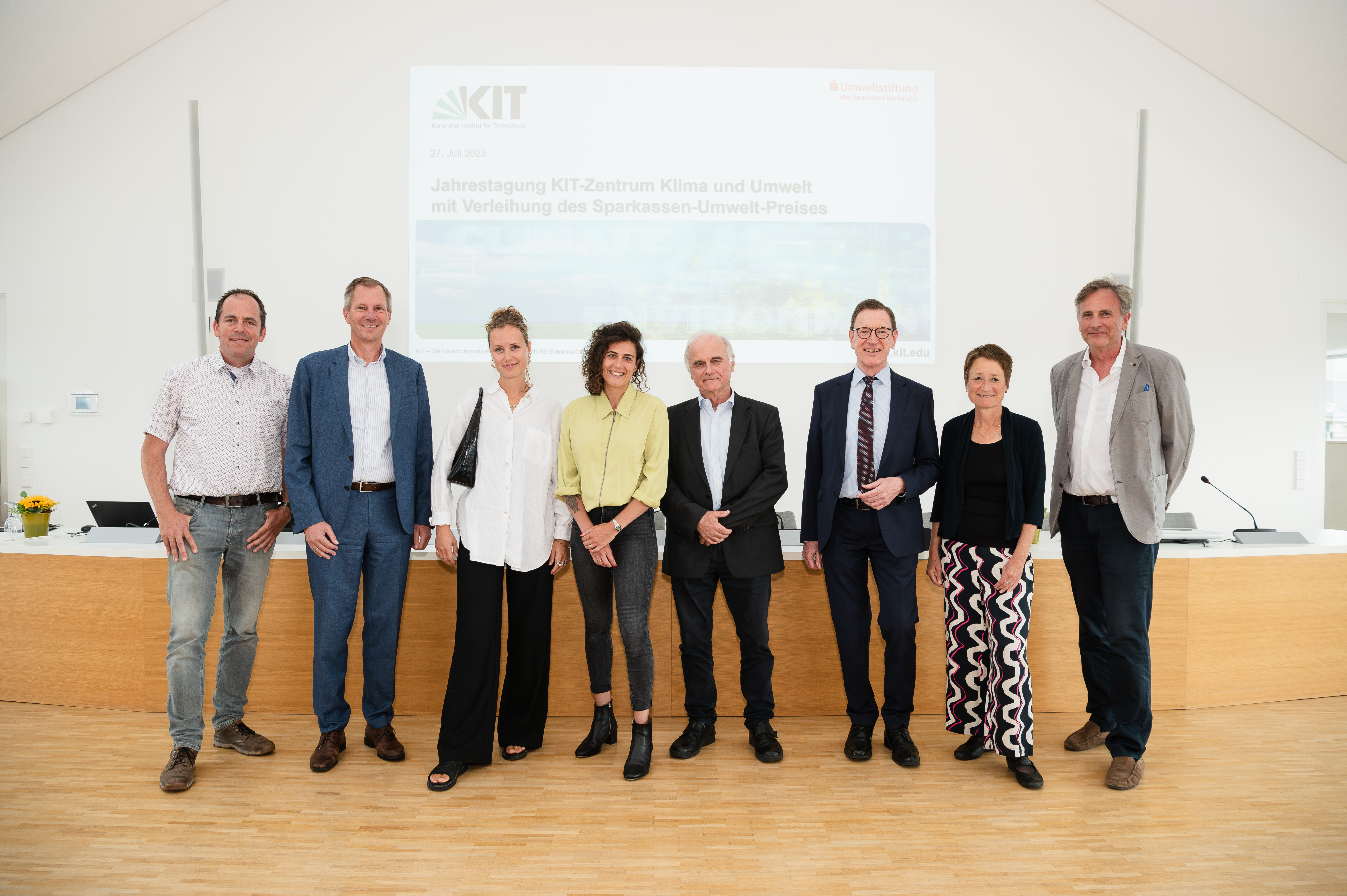
.jpg)
